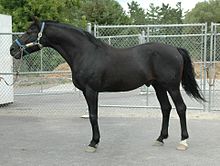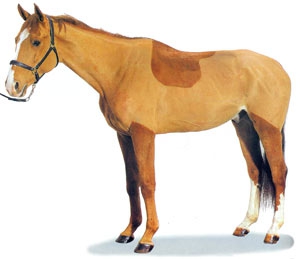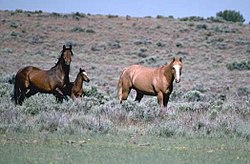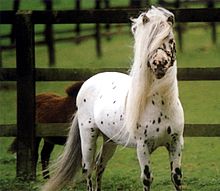Marvarian horse (part 2)
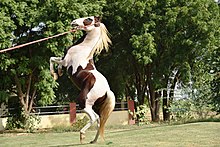 Breed description
Breed description
Bouncing marvari
The average growth of marvari is 152-163 cm. Horses originating from different parts of India, as a rule, have a height in the range of 142-173 cm. They can be bay, gray, red, salted and pinto. Despite the fact that white dominant horses are bred in India for religious purposes, they are usually not recorded in the studbook. Gray and pinto horses are considered the most valuable. Ravens are considered unhappy, and their color is a symbol of death and darkness. Horses that have a white mark on their faces and four socks are considered lucky.
Marwari Ears
The head is large, the profile is straight, the ears are bent inward, in length can be from 9 to 15 cm and rotate 180 degrees. If the horse is looking straight ahead, the tips of the ears should be in full contact with each other. In the world only Indian horses (besides marvari it is also kathiyavari) are endowed with this distinctive feature. The neck is thin, with a pronounced withers, the chest is deep. The shoulders are fairly straight, which in turn makes it easier for the horse and allows it to move quickly and naturally along the sand. With this structure of the shoulder, it is much easier to pull the legs out of deep sand. At the same time, speed qualities are reduced, but the horse’s move becomes very soft and comfortable for the rider. Marwari usually have a long and sloping croup. The legs are thin and long, the hooves are small but well formed.
A Marvari horse often exhibits a natural gait close to the pace called rewal, afkal, or rive. Curly hair and its location are important for Marvari breeders. Horses with long curls on their necks are called devans and are considered lucky, and horses with curls under their eyes are called anusudal and unpopular among buyers. It is believed that the curls on the brushes bring victory. It is suggested that horses should have the correct proportions based on the width of a finger, which are said to be equal to the five grains of barley. For example, the length of the face should be between 28 and 40 fingers, and the length from the back of the head to the tail should be four times the length of the face. [2]
Due to their military past, these horses can do without water and food for several days, they are strong and maneuverable. The curved ears of marvari sensitively pick up any sounds, and the silky skin perfectly resists the harsh desert climate, where it is hot during the day and cold at night. Marvars are not at all timid and phenomenally smart, so that, despite the hot temperament, you can rely on them in any situation. Marvari horse is patient and trusting with a person, reacts dispassionately to any stimuli. Marvari hatched in the desert, and this was reflected in the physique of the representatives of the breed: their legs are strong, and the muscles of the back and croup are developed enough to quickly move on unsteady sands. [3]
Genetic research
As a direct result of indiscriminate breeding practices, as of 2001 there were only a few thousand purebred Marvari horses. Studies have been conducted to study Marwari horse genetics and its relationships with other Indian and non-Indian horse breeds. Six different breeds have been identified in India: Marvari, Kathiawari, Pony Spiti, Pony Bhutia, Pony Manipuri and Zanskari. These six are different from each other in terms of unique characteristics and different agro-climatic conditions in the different areas of India where they originated. In 2005, a study was conducted to identify past genetic bottlenecks in a Marvari horse. The study showed that the DNA of the tested horses showed no signs of a genetic bottleneck in the breed’s history. However, as the population has declined rapidly in recent decades, there may have been bottlenecks that were not identified in the study. In 2007, a study was conducted to evaluate genetic variation among all Indian horse breeds except katyavari. Based on the analysis of microsatellite DNA, marvars were recognized as the most genetically excellent breed of the five studied, and they are the most distant from Manipuri. None of the breeds had close genetic ties with purebreds. Marvari differed from other breeds both in physical characteristics (mainly in height) and in adaptability to the environment. Physical differences were attributed to various ancestors: Marvari horses are closely related to the Arabian horse, while four other breeds are allegedly descended from a Tibetan pony. [2]
Breed use
Marvari are used for horse riding, pack transport, crew and agricultural work. Marvars are often crossed with thoroughbreds to produce a more versatile horse. They are especially suitable for dressage, in particular due to natural movements. Marvars are also used for equestrian polo, sometimes playing against thoroughbreds.
Horses are ideal for multi-day horseback riding, when riders overcome several tens of kilometers a day, making their way through mountains or sand dunes. [3]
